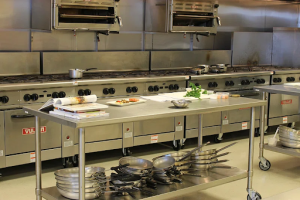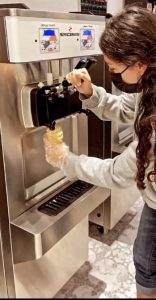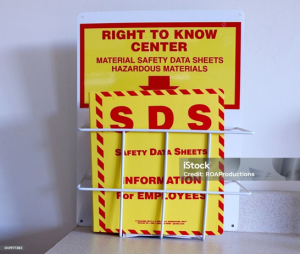62 10.1: Cleaning

Clean versus Sanitized
 In a food operation, it is important to understand the difference between clean and sanitized. A surface that is clean is simply free of visible soil. There is no food, dust, dirt or other particles on a surface that can be detected by a human eye. A surface can be clean and still contain pathogens or other harmful substances. A surface is sanitized when pathogens are reduced to safe levels or eliminated. Surfaces must be cleaned first before being sanitized.
In a food operation, it is important to understand the difference between clean and sanitized. A surface that is clean is simply free of visible soil. There is no food, dust, dirt or other particles on a surface that can be detected by a human eye. A surface can be clean and still contain pathogens or other harmful substances. A surface is sanitized when pathogens are reduced to safe levels or eliminated. Surfaces must be cleaned first before being sanitized.
Clean
Surfaces in food operations should be easily cleanable. Food employees should be able to access all surfaces, food contact or not, to remove any food debris, dirt, or dust particles. Kitchenware and equipment that come in contact with food should be easily cleanable with the ability to access all food contact parts. Equipment that is not permanently sealed to the floor or countertop, should be easy to move to allow access to the surface below for cleaning.
Materials that are used to construct kitchenware,utensils, and food contact surfaces should: 
- Be safe
- Be durable, corrosion resistant and nonabsorbent.
- Have a smooth finish and be resistant to pitting, chipping, scratching or decomposition. Surfaces that have these imperfections allow for pathogens to attach to the surface and establish a biofilm. Once formed, biofilms are highly resistant to further cleaning and sanitizing and can pose a food safety hazard.
- Be designed to withstand continued use and cleaning in addition to retaining its original characteristics for the life expectancy.
- Equipment and kitchenware should be regularly inspected to ensure it is in good working order and not physically or chemically contaminating food.
Equipment that cannot be taken apart to clean can be cleaned in place (CIP). Examples of equipment that are designed to be cleaned in place are tanks, mixers and ice cream machines. Detergent is circulated through a closed system to clean the equipment. Once clean, water is used to rinse the detergent, and a sanitizing solution is then circulated and drained. This process should be performed every 24 hours.
Cutting boards should be made of safe, durable and non-absorbent material. The most common material used for cutting boards is plastic because of its nonabsorbent and durable characteristics. Wood cutting boards are acceptable in foodservice if a hardwood is used. Examples of hardwoods include Rosewood and Maple. Inspection of cutting boards for cracks, scores and grooves should be conducted regularly. Damaged cutting boards can harbor microorganisms and therefore be resurfaced or disposed of.
A can opener must be cleaned and sanitized as it is exposed to food. The cutting edge of a can opener pierces the metal can and then comes in contact with the food inside. The food contact surface of the can opener must be cleaned and sanitized after each use.
Filters, hood vents or other grease extracting equipment should either have the ability to be taken apart to clean or cleaned in place.
Non-food contact surfaces, including floors and trash cans only need to be cleaned, not sanitized. Non-food contact surfaces should be constructed of nonabsorbent, smooth and corrosion resistant materials. Areas that are hard to clean can attract pests and rodents in addition to pathogenic growth. Non-food contact surfaces should be designed to keep surfaces clean.
 Cleaning can be facilitated using an approved cleaning agent for foodservice. The cleaning agent can be a solution of soap, detergent (alkaline), degreaser, abrasive cleaner, delimer (acidic) cleaner or other cleaning agent that is used according to the manufacturer’s instructions for use.
Cleaning can be facilitated using an approved cleaning agent for foodservice. The cleaning agent can be a solution of soap, detergent (alkaline), degreaser, abrasive cleaner, delimer (acidic) cleaner or other cleaning agent that is used according to the manufacturer’s instructions for use.
A safety data sheet (SDS) must be provided for every chemical used in the facility. All chemicals must be safe for employees to use, personal protection equipment (PPE) provided. The SDS binder should be stored in an accessible location to all employees. The SDS provides information on how to use the chemical properly, active ingredients, first aid information and chemical disposal instructions.
the application of cumulative heat or chemicals on a cleaned food contact surface that, when evaluated for efficacy, is sufficient to yield a reduction of 5 logs, which is equal to a 99.999% reduction of representative disease microorganisms of public health importance.
a characteristic of surfaces that are readily accessible and made of such materials, finish and so fabricated that residue may be effectively removed by normal cleaning methods.
Food preparation and storage utensils.
a food contact implement or container used in the storage, preparation, transportation, dispensing, sale, or service of food, such as kitchenware or tableware that is multiuse, single service, or single use.
A surface of equipment or a utensil with which food normally comes into contact or a surface of equipment or utensil from which food may drain, drip, or splash into a food, or onto a surface normally in contact with food.
material that maintains acceptable surface cleanability characteristics under prolonged influence of the food to be contacted, the normal use of cleaning compounds, and sanitizing solutions, and other conditions of the environment.
Equipment designed to clean and sanitize food contact surfaces within a fixed system, ensuring thorough sanitation without the need for disassembly.
equipment surfaces routinely exposed to splash or food debris are required to be constructed of nonabsorbent materials to facilitate cleaning.
